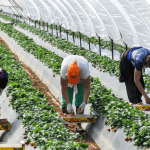UK Warehousing 2017 – A Boom Sector

The UK warehousing boom 2017: the warehouse sector has experienced a surge in demand in recent years as Amazon, discount supermarkets and retailers continue to expand rapidly and as more and more businesses look to sell an ever-growing range of products online, replacing high street footfall.
In 2017 UK Warehousing employed around 118,000 people, had an annual turnover of £14bn, an annual growth rate of 2.8% (2012-2017) and was made up of 3,009 businesses.
UK Warehousing Sector Trends
- Warehouses have now developed into distribution centres, where goods can be finished, packed and held in preparation for final delivery (e.g. Amazon fulfilment centres).
- Alongside distribution centres there is also now the need to fulfil high street stores, service click & collect, process online orders for next day delivery and in some cases within the hour in order to allow major retailers to favourably compete with competitors such as Amazon.
- The number of large-scale frozen-food warehouses is expected to increase In 2017/2018.
- Online sales are projected to make up more than a fifth of UK retail sales by the end of 2020.
UK Warehousing Space – Potential Barrier To Future Success
- The phenomenal increase in demand in the sector has however squeezed supply of available warehousing space, falling by 71% since 2009 with just over 14 months of supply left. Lack of space may therefore be a barrier to future growth.
- Amazon has been cited as one of the main drivers for the current shortage of warehouse space in the UK, with Amazon occupying more than a quarter of UK warehousing space in 2016 and supermarkets accounting for less than a quarter of warehousing space in 2017.
- The UK Warehousing Association recently commissioned a report highlighting “a critical lack of real estate supply and appropriate development in the logistics sector”. According to UKWA CEO Peter Ward, ‘Policy makers must move to legislate to allow for the growth of warehousing space or risk developing a critical pinch point for UK industry’, for example requesting local councils to allocate land for industrial buildings. The government itself also recently announced that that extra inland customs clearance depots could be established to free up capacity in and around ports where possible by upgrading existing handling and distribution facilities. Temporary warehouse buildings may also provide a solution to the space issue.
Key Players – Developments 2017/2018
- Amazon announced in July 2017 that it was planning to expand its UK workforce by 5,000 permanent roles, bringing its total UK workforce to 24,000 and the number of fulfilment centres it has in the UK to 15.
- Aldi plans to build a £75m UK distribution centre in Bedford creating 400 jobs in 2017.
- Lidl is to create 500 jobs at a new Peterborough warehouse in 2017 which will become its largest warehouse in the UK to date and is the sixth new distribution centre to be announced within the past year.
- Tesco is currently conducting a huge recruitment drive to fill 160 new positions at its new distribution centre in Reading.
Brexit – Impact On The UK Warehousing Skills Shortage
- Warehousing has relied on EU labour for some years – some 15% of logistics workers and 21% of forklift drivers currently come from elsewhere in the EU.
- The availability of labour post Brexit is a now a major concern for the sector.
- The shortage of labour was already a problem for the sector before the triggering of Article 50 – for example Amazon’s increased warehouse needs have led to a steep growth in demand for warehouse workers, with a consequent drain on the availability of labour.
- Article 50 has exacerbated this shortage along with the weaker pound and promoted an exodus of EU workers.
- In future, UK warehouses may need to mitigate the effect of the looming labour shortage by increasing efficiency in two areas: labour productivity and warehouse design. Warehousing companies may need to increase the participation of domestic workers and in some instances address their productivity gap and also increase automation in order to maximise the return from the workers they do have.
UK Warehousing & Future Automation
- In the UK, 22% of warehousing, distribution and transportation and employers think more than 30% of jobs will become automated in the next 10 years.
- Asda operates a fully automated distribution warehouse in west London;
- Amazon’s new Bolton fulfilment centre in 2018 will be one of a new generation of Amazon facilities that will see staff work alongside robots. The centre will be equipped with advanced robotics technology provided by the company’s Amazon Robots division. The automated technology is designed to help lift and move products around the plant.
Ten Live Group – Award-Winning 24/7 Warehouse Recruitment
Quality, reliable and highly-skilled warehouse candidates, from forklift drivers to pickers/packers, to warehouse supervisors, managers and support services for flexible temporary and permanent contracts throughout Scotland, across the UK and internationally.
We Are Currently Recruiting Volume Reach Drivers & Warehouse Operatives
Click here for more info!
Contact
Visit our website for more information!
Tel: 01236 702 007
E-mail: info@tenlivegroup.com
SOURCES
Total Logistics
UK Reuters
Ibis World
Telegraph
UK WA
UK WA
UK WA
UK WA
FT
The Load Star
The Guardian
The Guardian
AOL
Get Reading
Snap Fulfil











